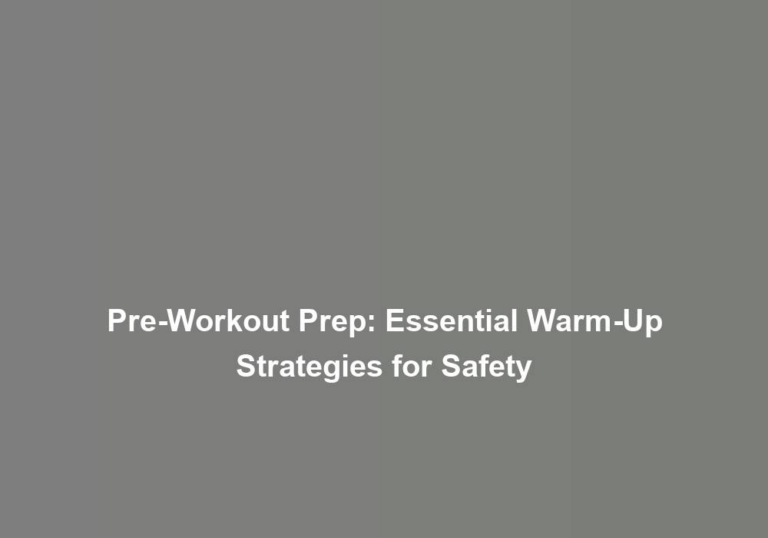Safety in Seconds: Time Management for Effective Injury Prevention in Workouts
YouG??re constantly juggling work, family, and personal commitments, so finding time for your workouts can feel like a challenge. But when it comes to injury prevention, every second counts. How can you effectively manage your time in workouts to prioritize safety without sacrificing efficiency? LetG??s explore some practical strategies to help you stay injury-free and make the most out of your training sessions.
Importance of Time Management in Workouts
To maximize the effectiveness of your workouts, efficient time management is crucial. Finding the time to work out can be challenging, but itG??s essential to make the most of the time you have. Time efficiency is key to fitting in a well-rounded workout while preventing injuries. By planning your workouts effectively, you can ensure that you incorporate proper warm-up and cool-down periods, as well as injury prevention techniques.
When it comes to time efficiency, itG??s important to focus on compound exercises that work multiple muscle groups at once. This allows you to get a full-body workout in a shorter amount of time. Additionally, incorporating high-intensity interval training (HIIT) can maximize the effectiveness of your workouts in a shorter period. These efficient workouts not only save time but also prevent overuse injuries that can occur with prolonged, repetitive movements.
Injury prevention techniques are another critical aspect of time management in workouts. ItG??s essential to allocate time for proper warm-ups, including dynamic stretches, to prepare your muscles and joints for exercise. Similarly, dedicating time to cool down and stretch can help prevent muscle stiffness and reduce the risk of injury. By efficiently integrating these injury prevention techniques into your workout routine, you can save time in the long run by avoiding setbacks due to injuries.
Quick Safety Checks for Effective Prevention
Ensure you perform quick safety checks before beginning your workout to effectively prevent injuries. Pre-workout safety checks are crucial for creating a safe exercise environment. Start by checking the condition of your equipment, such as ensuring that weights are secure and exercise machines are functioning properly. Verify that the workout area is clear of any obstacles or hazards that could cause tripping or falling during your routine. Additionally, itG??s important to assess your own physical state. Listen to your body and take note of any discomfort or pain that could indicate an underlying issue. Once your workout is complete, donG??t overlook the significance of post-workout checks. This involves inspecting your body for any signs of strain, injury, or unusual soreness. ItG??s also important to clean and store your equipment properly to ensure that itG??s ready for safe use during your next workout session. By incorporating these quick safety checks into your fitness routine, you not only reduce the risk of injuries but also create a sense of security and well-being. Remember, your safety is a top priority, and by taking these proactive measures, you contribute to a safer and more inclusive workout environment for everyone.
Incorporating Injury Prevention Into Your Routine
Incorporate proper warm-up and cool-down exercises into your routine to help prevent injuries during workouts. A thorough warm-up increases blood flow to your muscles, preparing them for the demands of your workout. It also raises your body temperature, making your muscles more pliable and less prone to injury. Additionally, a cool-down helps gradually bring your heart rate and blood pressure back to normal, reducing the risk of dizziness or fainting. By making these exercises a standard part of your routine, you can significantly decrease the likelihood of workout-related injuries.
Injury prevention strategies are essential for maintaining a safe and effective workout routine. ItG??s crucial to listen to your body and recognize the difference between discomfort and pain. Ignoring pain can lead to more severe injuries, so if something doesnG??t feel right, donG??t push through it. Instead, consider modifying your workout to accommodate any discomfort. Whether itG??s adjusting the intensity, duration, or type of exercise, making these modifications can help prevent injuries and ensure that you can continue to pursue your fitness goals without setbacks.
Incorporating injury prevention into your routine also involves being mindful of your form during exercises. Proper form not only maximizes the effectiveness of your workout but also minimizes the risk of injury. Take the time to familiarize yourself with the correct form for each exercise and focus on maintaining it throughout your workout. By implementing these injury prevention strategies and workout modifications, you can create a safer and more sustainable fitness routine.
Maximizing Efficiency Without Compromising Safety
Remember to maintain proper form and adjust your workout as needed to prevent injuries, while also maximizing efficiency without compromising safety. When it comes to maximizing efficiency without compromising safety in your workouts, efficient exercises and safety protocols are key. To achieve this, focus on incorporating compound movements into your routine. These exercises work multiple muscle groups at once, allowing you to get more done in less time while reducing the risk of overuse injuries. Examples of compound movements include squats, deadlifts, and bench presses. Additionally, consider implementing interval training, which involves alternating between periods of high-intensity exercise and rest. This approach not only improves cardiovascular fitness but also helps you complete a challenging workout in a shorter amount of time.
Incorporating safety protocols into your routine is equally important for maximizing efficiency without compromising safety. Always warm up before starting your workout to prepare your muscles and reduce the risk of strains or sprains. Incorporate proper rest periods into your routine to allow your body to recover and adapt to the demands of your workouts. Furthermore, listen to your body and make adjustments as needed. If something doesnG??t feel right, donG??t push through the pain. Instead, modify the exercise or seek guidance from a qualified trainer. By prioritizing efficient exercises and adhering to safety protocols, you can achieve your fitness goals while minimizing the risk of injuries.
Prioritizing Safety in Your Training Schedule
To prioritize safety in your training schedule, pay close attention to proper form and listen to your bodyG??s signals during workouts. ItG??s essential to incorporate injury assessment and risk evaluation into your routine. These steps can help you create a safe and effective training schedule that prioritizes your well-being.
Prioritizing Safety in Your Training Schedule
-
Injury Assessment: Take the time to assess any existing injuries or discomfort before each workout. By acknowledging and addressing these issues, you can prevent them from escalating and causing further harm. This proactive approach shows that you value your bodyG??s well-being and are committed to staying safe during your training.
-
Risk Evaluation: When planning your workouts, consider the potential risks associated with each exercise or activity. By identifying and minimizing these risks, you demonstrate a deep understanding of the importance of safety in your training schedule. This thoughtful consideration fosters a sense of belonging within a community of individuals who prioritize their health and safety.
-
Communication and Support: Create an environment where open communication about safety concerns is encouraged. Whether itG??s discussing proper form or sharing injury prevention tips, fostering a supportive network within your training community can provide reassurance and a sense of belonging. Knowing that youG??re part of a group that values safety can motivate you to prioritize it in your training schedule.
Conclusion
YouG??ve learned how to make safety a priority in your workouts by managing your time effectively. By incorporating quick safety checks into your routine, you can prevent injuries without compromising efficiency. Remember to prioritize safety in your training schedule and make it a habit to maximize your workout time while keeping yourself safe. So go ahead, enjoy your workouts knowing that youG??re taking the necessary steps to stay injury-free.







